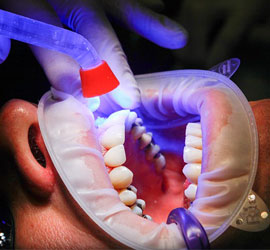In most cases, the natural colour of teeth is within a range of light greyish-yellow shades. Teeth naturally darken with age and their appearance can be affected by the accumulation of surface stains acquired from the use of tobacco products and the consumption of certain foods or drinks.
Teeth whitening is ideal for people who have healthy, unrestored teeth (no fillings) and gums. Individuals with yellow tones to their teeth respond best. But this cosmetic procedure is not recommended for everyone.

When it comes to tooth-whitening, you’ve got two options: in-office-based teeth bleaching, or at-home care.
Both tooth-whitening options use peroxide-based bleaching agents. At-home systems contain from 3% to 20% peroxide (carbamide or hydrogen peroxides). In-office systems contain from 15% to 43% peroxide.
Generally, the longer you keep a stronger solution on your teeth, the whiter your teeth become. However, the higher the percentage of peroxide in the whitening solution, the shorter it should be applied to the teeth. Keeping the gel on longer will dehydrate the tooth and increase tooth sensitivity.
There are pros and cons to each option, but before you try at-home tooth-bleaching kits, be sure to talk to your dentist. Not everyone will see good results.
Bleaching will not whiten porcelain crowns or composite tooth-colored bondings.
In-Office Tooth Whitening
Teeth whitening done by your dentist can get teeth brighter faster. The bleaching solution is usually much stronger than at-home kits. Also, heat, light, or a combination of the two may be used to speed and intensify the whitening process.
At-Home Teeth Bleaching
Tray-based tooth bleaching systems. With this teeth whitening option, a mouth guard-like tray is filled with a peroxide-based bleaching gel or paste and placed over the teeth for one to several hours a day for up to four weeks. You can buy tray-based tooth whitening systems over-the-counter or have one custom-fitted by your dentist.
